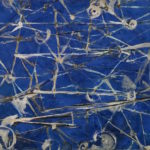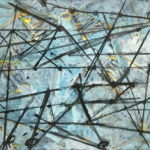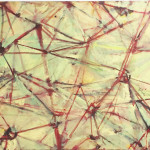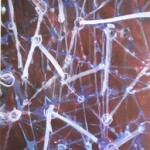Biography
Natalie Edgar (b. 1935)
“Natalie Edgar’s work grows out of the transformative Abstract Expressionist milieu of which she was a part when, in studios scattered around the Village, unknown artists shifted the focus of the art world from Paris to New York. Her paintings, however, are not bound by that tradition; she has created something uniquely her own. Edgar’s radiant paintings soar, as the shapes that cover her canvas appear simultaneously weightless and solid. She manages to create a profound light that doesn’t emanate from the surface of the canvas, but rather mysteriously from somewhere beneath it. Her brushstrokes co-exist as broad, flat, emphatic statements alongside lines that quietly shiver. But it is her works of the past three years that make the most brilliant statements. Edgar has harnessed energy in these painting to create her most emphatic, thrilling pieces. Typically, when an artist has had a decades-long career, she retreats to the safety of the familiar in her work. Luckily for us, Edgar has done the opposite. Her latest paintings exhibit a dynamism and intrigue that feels profound and utterly new.”
-Mary Gabriel, author of Ninth Street Women, Lee Krasner, Elaine de Kooning, Grace Hartigan, Joan Mitchell, and Helen Frankenthaler: Five Painters and the Movement That Changed Modern Art
Growing up in New York City, Edgar was exposed to a profusion of art, a perfect environment for shaping the amazing and raw talent that she possesses. In 1950, Natalie started studying art at Brooklyn College, from which she graduated in 1954. She learned from some of the most prominent artists and painters of the time, including Ad Reinhardt and Mark Rothko. Moving in this kind of circle of artists, Edgar learned that the point of art is to present ideas not the art-making process. Art should be truthful and honest.
She further developed her artistic expression while attending Meyer Schapiro classes. From 1960-1973 Edgar wrote for ArtNews, working for Tom Hess. Gaining exposure to a variety of artists’ studios through visits, she found her writing experience with ArtNews to be the ultimate education. It was through writing that Edgar learned about painting and how to understand the burgeoning field of Abstract Expressionism. Natalie Edgar met and fell in love with Philip Pavia, a renowned sculptor known as one of the original members who set up The Club, a group which gathered artists around the ideas and philosophies behind art. Some of the leading artists of the New York art scene, such as Bill and Elaine de Kooning, Ibram Lassaw, Franz Kline, and Mercedes Matter, another founding member, were frequent visitors of The Club. Since 1980, the couple started their journey around Italy, eventually discovering Pietrasanta, a small town in Tuscany. They decided to spend every summer there. The breathtaking scenery became Natalie’s second studio, and yet another “school” where she discovered color, volume and rhythm.
From 1966 until 1988, Edgar held the position of Adjunct Assistant Professor at Queens College, CUNY, teaching Art History. Subsequently, she moved to the New School of Social Research, where she taught Painting until 1994. Among many awards, she was a recipient of Pollock-Krasner Foundation Grant in 2010 and 2015, The Judith Rothschild Grant in 2006 and 2009 and the Mies and Hans Hofmann Grant in 2007. An eminent New York artist, Natalie has exhibited her works extensively in her native city, participating in both solo and group exhibition.
Living through the mythos and aftermath of Abstract Expressionism as a thinking painter, Edgar has not stopped challenging her methodology of what it means to create a painting. Her work positions itself as open enigmas teetering on the psychological, as the artist notes, “…I want the viewer to ask ‘where is the system?’…It can not be figured out.” Whether the lattices present a temporal awareness or seek to interlock, it’s that connectivity that Edgar has experienced throughout her lifetime.
Edgar’s life experience as artist and writer is conveyed through her art. William Benton writes of the artist, “The freshness of Natalie Edgar’s pictures…doesn’t come from an effort to build a new world, but from the particular lilt of being at home in one that already exists.” (The Brooklyn Rail, April 2, 2014)

 Corelli
Corelli
 Bounce Back
Bounce Back
 Gain Time
Gain Time
 On My Way
On My Way